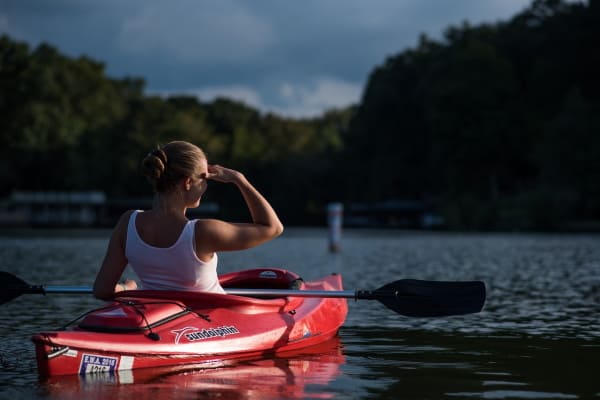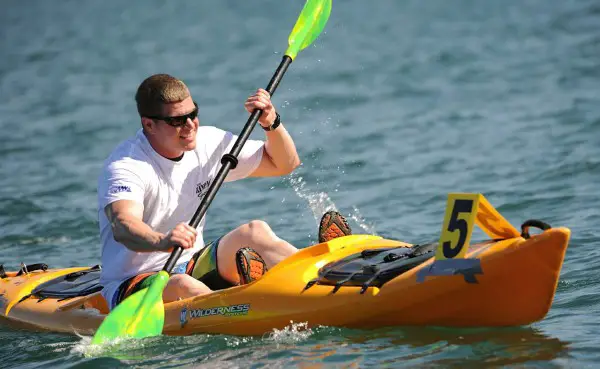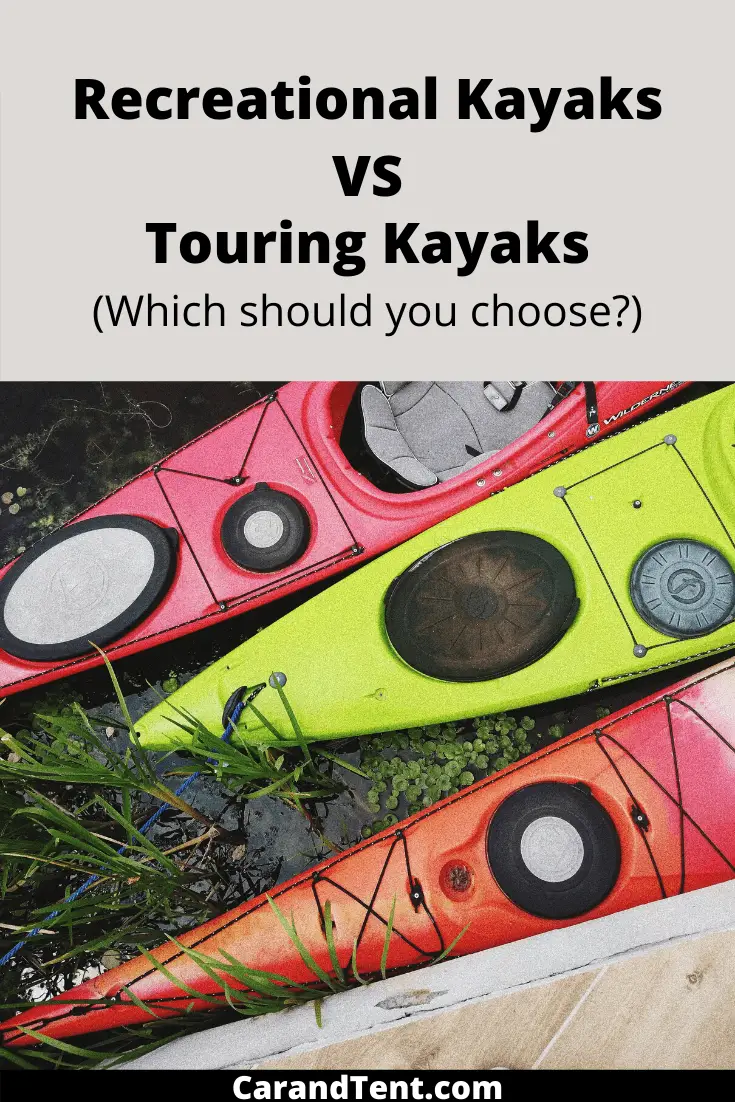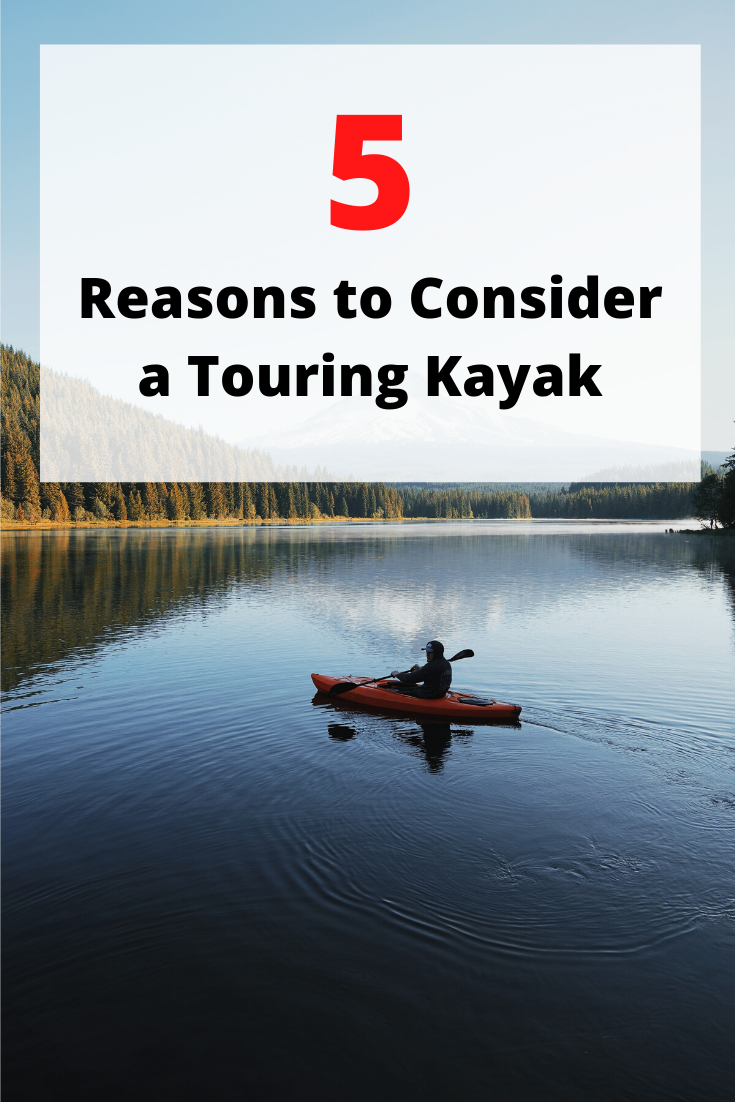
Kayaks come in all different shapes, sizes, models, and types. Two of the most popular types of kayaks are recreational kayaks and touring kayaks.
Which type of kayak you buy will determine what you can and cannot do with it, so it’s important that you buy the right one. In this post, I’ll help you decide which one is best for you.
Table of Contents
Recreational Kayaks
Recreational kayaks are the most popular kayaks on the market today. They make great beginner kayaks and casual paddlers as well as anglers often buy them and keep them for life.
These types of kayaks come in sit-on-top and sit-in models and they work well in slow waters such as lakes, ponds, and some rivers.
Here are some of the advantages of recreational kayaks:
- They offer the most stability.
- They’re easier to get in and out of.
- They are usually less expensive than other kayaks.
- They aren’t as long as touring kayaks.
- They’re easier to operate.
Stability
Recreational kayaks are wider than other kayaks. This gives them increased stability.
Since recreational kayaks are much less likely to capsize, they are much more forgiving for beginners to learn on. Also, they’re better for people who are fishing since a good catch is less likely to pull the kayak over.
Easier Entry and Exit
The increased stability is one factor that makes recreational kayaks easier to get in and out of. The increased width is another factor.
On top of this, recreational kayaks have cockpits that are more open. In fact, most recreational kayaks are sit-on-top kayaks which are generally easier to get in and out of when compared to sit-in kayaks.
For more information on sit-in vs sit-on-top kayaks, see my post titled, “Sit-in Vs Sit-on-Top Kayaks“.
Cost
Recreational kayaks tend to cost less money when compared to touring kayaks. They’re also pretty easy to find used so you can save even more money.
The reason these kayaks cost less is that they are built from heavier and possibly less durable materials. However, don’t let this stop you from buying one as a recreational kayak doesn’t need to be as durable as a touring kayak. They also don’t need to be made from lightweight materials as they are generally shorter which helps to keep down the overall weight of the kayak.
A new bare-bones, single-passenger recreational kayak will cost you somewhere between $150.00 to $250.00. Buy used on Craigslist at the end of the season and you may be able to get one for less than $100.00.
Costs can and do go up from here depending on the extra features the kayak has to offer.
Length
Recreational kayaks are shorter than touring kayaks. In fact, they generally come in the 10′ to 12′ range while a touring kayak generally starts out at about 14′ and can go up from there. This size difference gives recreational kayaks a few advantages over touring kayaks.
The first advantage is just that they’re easier to transport. It isn’t unusual for a kayaker to throw their recreational kayak on the roof of their SUV or into the back of their pickup truck.
The second advantage is that a shorter recreational kayak has a better turning radius than a touring kayak. This makes the kayak easier to maneuver.
Ease-of-Use
A recreational kayak is the easiest type of kayak to use. It requires little if any training to be used safely.
Beginner kayakers will find that the increased stability and increased maneuverability make it easy to learn how to properly paddle a kayak without the added stress of having to worry about capsizing or planning out turns. Also, most recreational kayaks will not have rudders so you don’t have to worry about learning how to operate foot controls.
Touring Kayaks
A touring kayak is a more advanced kayak that is good for fast water. Sometimes the term touring kayak is also synonymous with the term sea kayak but it will depend on the manufacturer.

Here are the advantages of touring kayaks:
- They’re faster.
- They can handle rougher waters.
- They’re easier to roll with.
- Tracking is more reliable.
- They offer more storage.
Speed
A touring kayak has a shape that is more narrow. This allows the kayak to move through the water at a faster speed.
On top of this, a touring kayak tracks better. By this, I mean that the kayak is more likely to move in a straight line as you paddle. This also improves the speed of the kayak.
Rough Waters
Touring kayaks are built for fast rivers, large lakes, and even the sea. The design of the hull allows them to cut through the water and with some skill, a touring kayak is less likely to capsize than a recreational kayak in rough currents or waves.
Also, a touring kayak has a smaller cockpit opening. This helps to reduce the amount of water that can get into the hull and makes it easier to put a kayak skirt on.
Rolling
A touring kayak is built with a hull design that makes it easier to roll into waves and strong currents. This means that even if a person capsizes, he or she still has a good chance of righting themselves.
Rolling doesn’t have to be done only in an emergency situation either. Some people like to practice rolling into waves just for the sheer fun of it. With a recreational kayak, you really don’t have this option.
Tracking
As we said earlier, a touring kayak tracks better. This makes kayaking with a touring kayak much more efficient. The more efficient paddling leads to the kayaker having the ability to travel further and in less time.
Tracking can also be controlled via a foot-controlled rudder. This makes it easier to turn without having to dramatically change the way you paddle.
Storage
Touring kayaks have longer hulls. The longer hulls result in a lot more storage. This additional storage is perfect for kayakers looking to go on long-distance kayak trips or overnight kayak camping trips.
In fact, some touring kayaks are so long that fishing poles can easily be broken down and put inside of the hull. This gives island anglers the ability to kayak out to the islands with larger fishing poles that they can use to surf fish off of the island.
Which One Should You Choose
The answer to this question really depends on what kind of trips you’d like to take with your kayak. If you’re looking to spend some time out on lakes and slow-moving rivers, you’re probably better off getting a recreational kayak.
On the other hand, if you’re looking go on long trips or to take on faster rivers, you’re probably better off with a recreational kayak.
If you’re still not sure, my advice would be to try a recreational kayak first. Go out on a few day trips and get used to kayaking. Once you’re comfortable with a recreational kayak, you might want to invest in some kayaking lessons with a touring kayak or possibly even a different type of kayak altogether.
Either way, you’ll have a better idea of what direction you’d like to go after you’ve spent some time on a recreational kayak.



